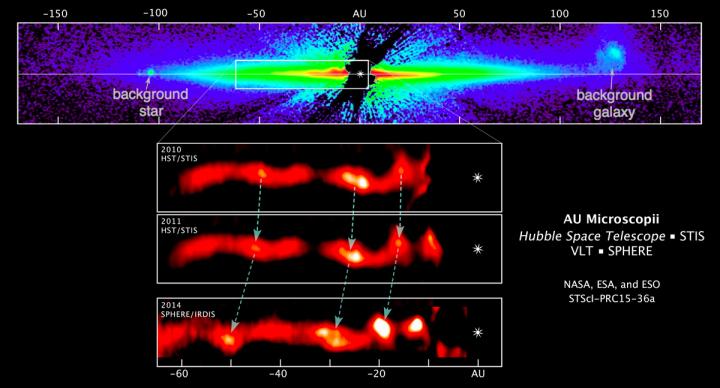Mysterious ripples found racing through planet-forming disk

This set of images of a 40-billion-mile-diameter edge-on disk encircling the young star AU Microscopii reveals a string of mysterious wave-like features. Astronomers discovered the ripples are moving across the disk at speed of 22,000 miles per hour. The cause of the phenomenon is unknown and never-before seen in stellar gas and dust disks. Credits: NASA, ESA, ESO, A. Boccaletti (Paris Observatory)
U Mic is located 32 light-years away in the southern constellation Microscopium. It is an optimal star to observe because its circumstellar disk is tilted edge-on to our view from Earth. This allow for certain details in the disk to be better seen.
Astronomers have been searching AU Mic's disk for any signs of clumpy or warped features that might offer evidence for planet formation. They discovered a very unusual feature near the star by using ESO's SPHERE (Spectro-Polarimetric High-contrast Exoplanet Research) instrument, mounted on the Very Large Telescope.
“The images from SPHERE show a set of unexplained features in the disk, which have an arc-like, or wave-like structure unlike anything that has ever been observed before,” said Anthony Boccaletti of the Paris Observatory, the paper's lead author.
The images reveal a train of wave-like arches, resembling ripples in water. After spotting the features in the SPHERE data the team turned to earlier Hubble images of the disk, taken in 2010 and 2011. These features were not recognized in the initial Hubble observations. But once astronomers reprocessed the Hubble images they not only identified the features but realized that they had changed over time. The researchers report that these ripples are moving — and they are moving very fast.
“We ended up with enough information to track the movement of these strange features over a four-year period,” explained team member Christian Thalmann of the Swiss Federal Institute of Technology in Zurich, Switzerland.
“By doing this, we found that the arches are racing away from the star at speeds of up to 10 kilometers per second (22,000 miles per hour)! Co-investigator Carol Grady of Eureka Scientific in Oakland, California, added, “Because nothing like this has been observed or predicted in theory we can only hypothesize when it comes to what we are seeing and how it came about.”
The ripples farther away from the star seem to be moving faster than those closer to it. At least three of the features are moving so fast that they are escaping from the gravitational attraction of the star. Such high speeds rule out the possibility that these features are caused by objects, like planets, gravitationally disturbing material in the disk. The team has also ruled out a series of phenomena as explanations, including the collision of two massive and rare asteroid-like objects releasing large quantities of dust and spiral waves triggered by instabilities in the system's gravity.
“One explanation for the strange structure links them to the star's flares. AU Mic is a star with high flaring activity — it often lets off huge and sudden bursts of energy from on or near its surface,” said co-author Glenn Schneider of Steward Observatory in Phoenix, Arizona. “One of these flares could perhaps have triggered something on one of the planets — if there are planets — like a violent stripping of material, which could now be propagating through the disk, propelled by the flare's force.”
The team plans to continue to observe the AU Mic system to try to understand what is happening. But, for now, these curious features remain an unsolved mystery.
The results will be published Oct. 8 in the British science journal Nature.
###
The Hubble Space Telescope is a project of international cooperation between NASA and the European Space Agency. NASA's Goddard Space Flight Center in Greenbelt, Maryland, manages the telescope. The Space Telescope Science Institute (STScI) in Baltimore, Maryland, conducts Hubble science operations. STScI is operated for NASA by the Association of Universities for Research in Astronomy, in Washington, D.C.
For illustrations and more information about AU Mic and the Hubble Space Telescope, visit: http://www.
Media Contact
All latest news from the category: Physics and Astronomy
This area deals with the fundamental laws and building blocks of nature and how they interact, the properties and the behavior of matter, and research into space and time and their structures.
innovations-report provides in-depth reports and articles on subjects such as astrophysics, laser technologies, nuclear, quantum, particle and solid-state physics, nanotechnologies, planetary research and findings (Mars, Venus) and developments related to the Hubble Telescope.
Newest articles

NASA: Mystery of life’s handedness deepens
The mystery of why life uses molecules with specific orientations has deepened with a NASA-funded discovery that RNA — a key molecule thought to have potentially held the instructions for…

What are the effects of historic lithium mining on water quality?
Study reveals low levels of common contaminants but high levels of other elements in waters associated with an abandoned lithium mine. Lithium ore and mining waste from a historic lithium…

Quantum-inspired design boosts efficiency of heat-to-electricity conversion
Rice engineers take unconventional route to improving thermophotovoltaic systems. Researchers at Rice University have found a new way to improve a key element of thermophotovoltaic (TPV) systems, which convert heat…



